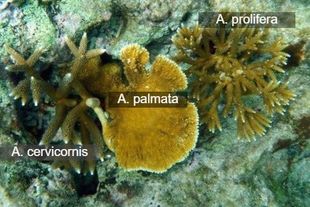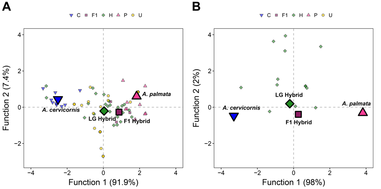Coral Hybridization
Patterns of Introgression in Acroporid Genomes
|
The sympatric corals Acropora palmata and A. cervicornis form the hybrid, A. prolifera, whose abundance has continued to increase, either through fragmentation or sexual reproduction, while the parental species decline. While previous work indicates that unidirectional gene flow into A. cervicornis, we identified backcross A. palmata indicating bidirectional hybridization.
We are using genomic sequence data (See Omic Resources) from the two parental species and their hybrids to further characterize the patterns of genomic synteny, divergence and introgression across hybrid zones. We identified genetic variants between the parental species (Kitchen et al. 2019, G3) that will allow us to understand introgression in the hybrids and has already led to the development of a coral SNPchip and STAG database (Kitchen et al. 2020, Scientific Reports). |
Symbiont Specificity
The hybrid larvae do not acquire their symbionts from their parents, and must take them up from the environment. We explored hybrid preference for parental symbiont "strains", whether they chose the A. palmata- or A. cervicornis-like symbionts. Penn State alum Hannah Reich (now a Postdoc at URI) found strain-specific markers using the draft Symbiodinium fitti genome to assess the genetic background of hybrid-symbiont associations. We found evidence of disruptive seleciton where symbionts are structured by host taxon, including a hybrid-like strain.
In press at Molecular Ecology.
In press at Molecular Ecology.

